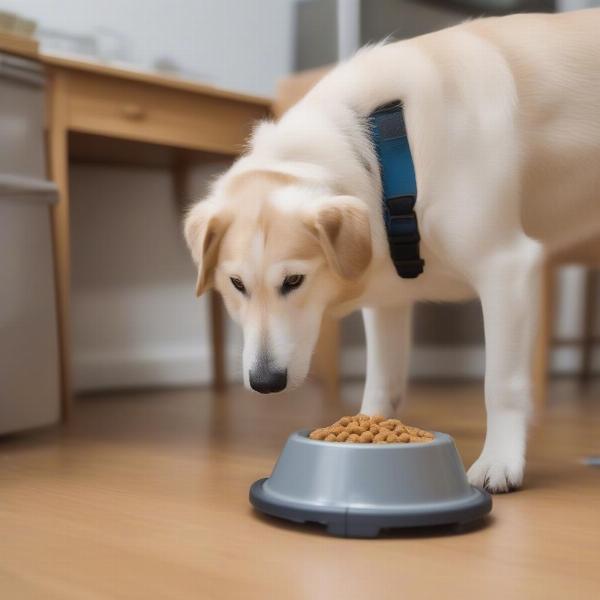Big dog slow feeders are a game-changer for ravenous pups. They transform mealtime from a frantic gulp-fest into a more relaxed and enjoyable experience. If you’re dealing with a big dog who inhales their food, a slow feeder can be the solution you’ve been searching for. This guide dives into the benefits, types, and how to choose the best big dog slow feeder for your furry friend.
Why Use a Big Dog Slow Feeder?
For many large breed dogs, mealtime is a race to the finish. This rapid eating can lead to a range of health issues, including bloating, vomiting, and even a life-threatening condition called Gastric Dilatation-Volvulus (GDV). Slow feeders combat this by physically obstructing the dog’s access to all the food at once, forcing them to eat smaller bites and slow down the process. This also has the added benefit of making mealtime more engaging and enriching.
Types of Big Dog Slow Feeders
There’s a variety of slow feeders on the market, each designed with different features and benefits. Some popular types for big dogs include:
- Mat-style feeders: These flat mats have raised ridges and textures that spread the kibble out, making dogs work for their food.
- Bowl-style feeders: These bowls have internal obstacles that force dogs to eat around them, slowing down their eating pace.
- Puzzle feeders: These interactive toys dispense food as the dog manipulates them, providing both mental and physical stimulation.
Choosing the Right Big Dog Slow Feeder
Choosing the right slow feeder depends on your dog’s size, breed, and eating habits. Consider these factors:
- Size: Ensure the feeder is appropriately sized for your big dog to comfortably eat from. large dog bowls can be a good starting point for finding the right size.
- Material: Opt for durable, non-toxic materials like stainless steel or heavy-duty plastic. Metal options, such as a metal slow feed dog bowl, are often preferred for their durability.
- Design: The complexity of the feeder should challenge your dog without frustrating them. Start with a simpler design and gradually increase the difficulty if needed. If you’re considering a crate feeder, dog crate bowl options that integrate slow feeding features are available.
Introducing Your Dog to a Slow Feeder
Introducing a slow feeder should be a gradual process. Start by adding a small amount of food to the feeder and letting your dog explore it. Gradually increase the amount of food as they get used to it. Avoid forcing your dog to use the feeder, as this can create negative associations. Positive reinforcement and patience are key.
 Dog Gradually Adapting to a Slow Feeder
Dog Gradually Adapting to a Slow Feeder
Conclusion
Big dog slow feeders are a valuable investment for any owner concerned about their dog’s eating habits. By slowing down mealtime, they help prevent health issues, provide mental stimulation, and promote a more enjoyable dining experience. With a little research and patience, you can find the perfect big dog slow feeder to help your furry friend enjoy healthier, happier meals. Remember to consider appropriate bowls for dogs when making your choice. You can also check out our guide on dog birthday gifts for more ideas on how to spoil your pup!
FAQ
- How do I clean a big dog slow feeder? Most slow feeders are dishwasher safe or can be easily hand-washed with soap and water.
- What if my dog still eats too fast with a slow feeder? Try a feeder with a more complex design or consider puzzle feeders for an added challenge.
- Are slow feeders suitable for all big dogs? Yes, but some dogs with flat faces or dental issues may find them difficult to use.
- Can I use a slow feeder for wet food? Some slow feeders are designed for both wet and dry food, while others are better suited for dry kibble.
- How long should it take my dog to eat from a slow feeder? The ideal eating time will vary depending on the dog and the feeder, but aim for a significant increase compared to their previous eating speed.
- What are the signs of bloat in big dogs? Signs of bloat include a distended abdomen, restlessness, excessive drooling, and retching.
- Where can I buy a big dog slow feeder? Pet stores, online retailers, and even some veterinary clinics sell slow feeders.
ILM Dog is a leading international website dedicated to providing expert advice on dog care and breeding. We offer comprehensive resources on dog breeds, health, training, nutrition, grooming, and much more. From selecting the perfect breed to understanding the nuances of senior dog care, ILM Dog has you covered. Contact us today for expert guidance: Email: [email protected], Phone: +44 20-3965-8624. Visit ILM Dog for all your dog-related needs.